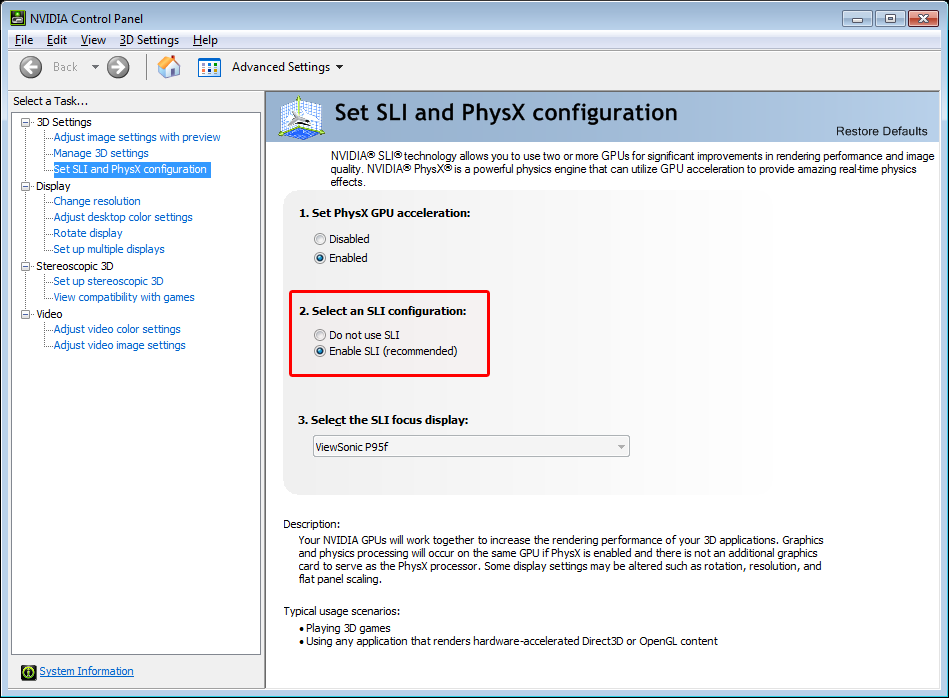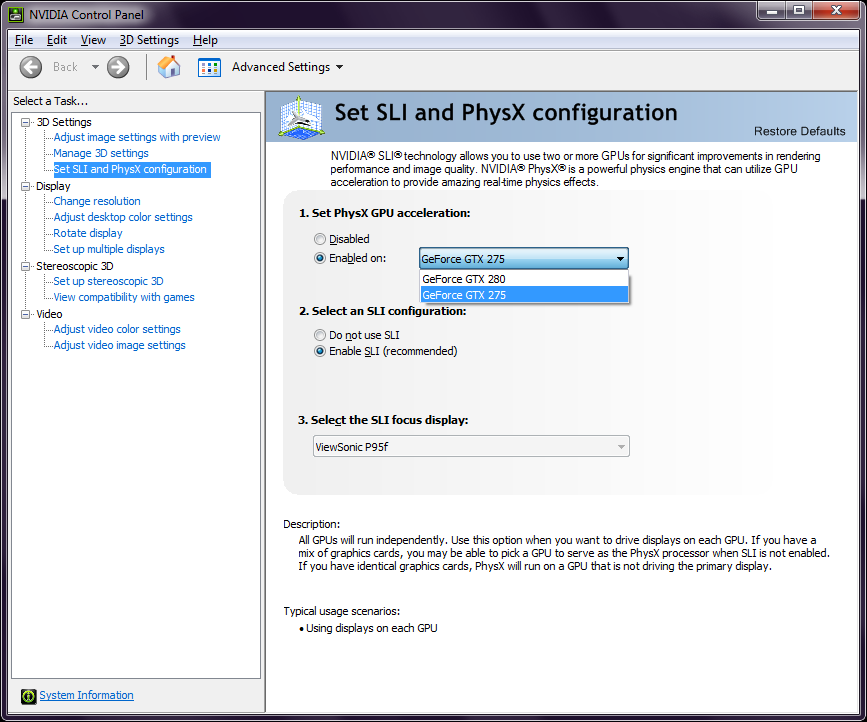Multi-GPU Setups: The Basics Of CrossFire And SLI
Motherboards with multiple PCIe slots are becoming the norm these days, and the trend is being fueled by multi-GPU configurations. Configuring Nvidia's SLI and AMD's CrossFire technologies is easy, but how much more performance can you expect from them?
Driver Installation On Nvidia Cards
The installation of multiple video cards is a piece of cake under Windows Vista and Windows 7, even if the cards or GPUs are from different manufacturers. Cards from AMD and Nvidia cooperate splendidly in multi-screen scenarios. If you want to increase 3D performance, however, CrossFire and SLI modes always require at least two graphics cards from the same chip manufacturer. Increasing 3D performance by mixing AMD and Nvidia cards is not possible (Ed.: Though this is true in most cases, Lucid's Hydra technology facilitates the mixing and matching of GPUs on boards equipped with its hardware, such as MSI's Big Bang Fuzion).
In order to distribute 3D rendering between two cards in SLI mode, you need to use two identical GPUs and similar frame buffers. Different GPUs do not work, nor do cards based on the same GPU but with different memory capacities, although the current drivers don't actually provide any error messages if cards with different chips are connected via the SLI bridge. Even though the bridge is silently accepted, there is no performance increase, as the driver cannot activate SLI mode. The SLI menu setting will only appear if the installed graphics cards are able to cooperate.
When using two or more Nvidia graphics cards, regardless of whether the GPUs match, one can be dedicated to physics acceleration (PhysX). This can be done even when two cards are working together in an SLI configuration and a third card is added. For these tests, two GeForce GTX 280s and a GeForce GTX 275 are connected with a three-way SLI bridge. The driver recognizes the pair of GeForce GTX 280 cards as an SLI configuration, and offers to reserve one of the GeForce GTX 280 cards or the additional GTX 275 for physics calculations. The drivers have no problem handling the three SLI-bridged graphics cards. The mismatching third card is simply ignored for SLI bonding.
Our benchmarks demonstrate interesting, if not expected, results. Performance is almost doubled by SLI bridging the two GeForce GTX 280 cards, while the additional GeForce GTX 275 has no effect on performance.
After installation, all necessary drivers are installed automatically and assigned to the respective graphics cards. If the installation is fresh, the driver announces an SLI configuration, and all you have to do is to activate it by checking a box. If everything goes well, the configuration then works and the graphics cards divide the 3D rendering workload as soon as you start a game with an SLI-profile assigned to it in Nvidia's driver. The feature can also be activated without using a physical bridge connector between the cards.
Get Tom's Hardware's best news and in-depth reviews, straight to your inbox.
Current page: Driver Installation On Nvidia Cards
Prev Page AMD Or Nvidia? Next Page Driver Installation On AMD Cards-
ramcrazy360 It's great to know there's so little difference between 8x and 16x preformance even with a 5850! I was worried about having a bandwidth issue with two 5770s, but it seems that won't be a problem.Reply -
Maziar Great review,however i wish you tested on resolutions like 2560x1600 and higher,because i think the main difference between 8x and 16x is in resolutions like that.Reply -
wildeast same as ramcrazy,Reply
i was going to get an i5 but that means a p55 mobo (x8+x8) not x58 (x16+x16), so i thought i should be getting x58 and i7 rig which is beyond my savings, thnx tom's am getting i5 + p55 now :) -
Tamz_msc Very nice article.It cleared a lot of confusion in my case.I would have liked to see scaling with increase in the number of CPU cores.Reply -
ruffopurititiwang Great article! Now we know what the deal is regarding multi-gpu and PCI-E lane speeds with mainstream setups.Reply
Now how about showing some love for top of the line setups? Can you apply the same tests to GTX 480/ATI 5870 Multi-gpu configuration + X58 mobo & 980X proc? -
rohitbaran On page 7, performance of Radeons in Alien vs Predator is not arranged properly with CPU speed.Reply -
lothdk rohitbaranOn page 7, performance of Radeons in Alien vs Predator is not arranged properly with CPU speed.Reply
All the tests are arranged by GPU performance not by CPU speed. -
TheStealthyOne I'll definitely be using this article as a reference for a dual 5850 machine I'm building :)Reply -
hixbot In every single TOMS article showing benches on CPU scaling, you use High resolutions with FULL AA and aniso! WHY?!Reply
I know thats how many would play the game, and it shows the performance that one would expect with different CPUs. It shows that we don't need to overclock or buy expensive CPUs, when the load (bottleneck) is on the GPU.
BUT if you would also show the CPU scaling in low resolutions and no AA/aniso, we could see how the CPUs might stack up. This is valuable for knowing how the CPUs perform in the future, when one might have upgraded the GPUs, and the bottleneck dissapears.
Yeah, yeah, this is not a CPU article... i know but still.. it shows CPU scaling, and every time I see CPU scaling demonstrated on toms, it's shown with a bottleneck on the GPU.
Humour us next time and include a bench or two with no GPU bottlneck (low res, eye candy). Just becaause that's not how we'd play the game, and just because the FPS would be insanely high, doesn't mean the numbers wouldn't be valuable. I complain about this in every article that includes CPU scaling.
It doesn't erk me that much here because this article isn't focused on CPUs. but for the love god, the next CPU article you do, when you test gaming, throw a bench or two in there with very low settings.

